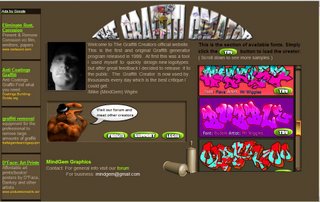The word "graffiti" derives from the Greek word graphein meaning: to write. This evolved into the Latin word graffito. Graffiti is the plural form of graffito. Simply put, graffiti is a drawing, scribbling or writing on a flat surface. Today, we equate graffiti with the "New York" or "Hip Hop" style which emerged from New York City in the 1970's.
Graffiti Culture
Graffiti quickly became a social scene. Friends often form crews of vandals. One early crew wrote TAG as their crew name, an acronym for Tuff Artists Group. Tag has since come to mean both graffiti writing, 'tagging' and graffiti, a 'tag'. Crews often tag together, writing both the crew tag and their own personal tags. Graffiti has its own language with terms such as: piece, toy, wild-style, and racking.
Graffiti Tools
At first pens and markers were used, but these were limited as to what types of surfaces they worked on so very quickly everyone was using spray paint. Spray paint could mark all types of surfaces and was quick and easy to use. The spray nozzles on the spray cans proved inadequate to create the more colorful pieces. Caps from deodorant, insecticide, WD-40 and other aerosol cans were substituted to allow for a finer or thicker stream of paint. As municipalities began passing graffiti ordinances outlawing graffiti implements, clever ways of disguising paint implements were devised. Shoe polish, deodorant roll-ons and other seemingly innocent containers are emptied and filled with paint. Markers, art pens and grease pens obtained from art supply stores are also used. In fact nearly any object which can leave a mark on most surfaces are used by taggers, though the spray can is the medium of choice for most taggers.
Graffiti in the 21st Century
As graffiti has grown, so too has its character. What began as an urban lower-income protest, nationally, graffiti now spans all racial and economic groups. While many inner-city kids are still heavily involved in the graffiti culture, one tagger recently caught in Philadelphia was a 27 year old stockbroker who drove to tagging sites in his BMW. Styles have dramatically evolved from the simple cursory style, which is still the most prevalent, to intricate interlocking letter graphic designs with multiple colors called pieces (from masterpieces).
Graffiti Style Art
While most taggers are simply interested in seeing their name in as many places as possible and as visibly as possible, some taggers are more contented to find secluded warehouse walls where they can practice their pieces. Some of these taggers are able to sell twelve foot canvases of their work for upwards of 10 - 12 thousand dollars.
Commercialization, the Web and the World
Graffiti shops, both retail and on-line, sell a wide variety of items to taggers. Caps, markers, magazines, T-shirts, backpacks, shorts with hidden pockets, even drawing books with templates of different railroad cars can be purchased. Over 25,000 graffiti sites exist on the world wide web, the majority of these are pro-graffiti. Graffiti vandalism is a problem in nearly every urban area in the world. Pro-graffiti web sites post photos of graffiti from Europe, South America, the Philippines, Australia, South Africa, China and Japan. Billions of dollars worldwide are spent each year in an effort to curb graffiti
one such site i found was,a graffiti creator http://www.graffiticreator.net/ where you can (online) create text images like graffiti

tried writing my name:


No comments:
Post a Comment